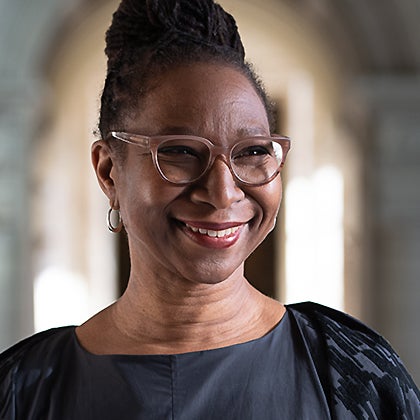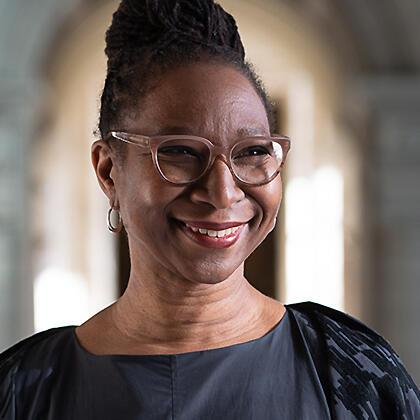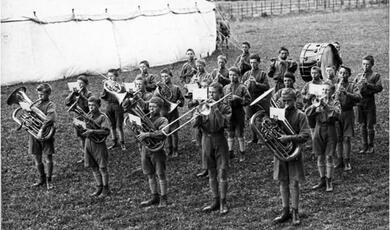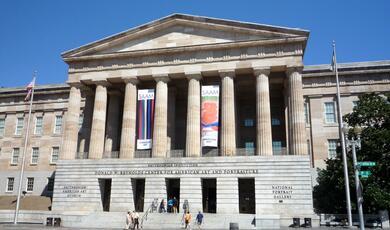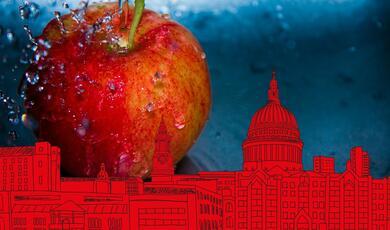The Politics of Fabric and Fashion in Africa 1960-Today
Share
- Details
- Text
- Audio
- Downloads
- Extra Reading
1960 was the year of Africa. Over seventeen countries rid themselves of colonial rule and a new sense of pride in being Black and African was expressed through myriad artforms, notably via the fashioning of the body.
Using objects in the V&As ‘Africa Fashion’ exhibition this lecture explores how fibre and fabric carried meaning in the moment of independence and carries meaning now in the cutting-edge work of Africa’s contemporary fashion creatives, Aphia Sakyi, Thebe Magugu and Artsi Ifrach.
Download Text
The Politics of Fabric and Fashion in Africa 1960-Today
Dr Christine Checinska
20th October 2022
Do clothes maketh the man, or woman for that matter?
How might fabric and fashion allow us to speak about ourselves and the way that we want to be seen?
The writer and cultural critic Sarat Maharaj once posed the question ‘textile art – who are you’? going on to suggest that we might understand textiles under the ‘chameleon figure’ of the ‘undecideable’; something that at first glance belongs to one genre yet, on closer inspection, seems to stretch and pull that genre right out of shape.[1]
The topic of fabric alone is a rich one, encompassing a breadth of techniques, a myriad of cultural meanings and the embodiment of countless stories. Together fabric and fashion do more than cover the body, they can become strategic means of self-expression. But fashion is also part of the way in which the unequal distribution of power in all societies is constructed, maintained and experienced as legitimate. Whilst the converse is true, fabric and fashion can also be used to challenge and reaffirm one’s position in society. This is what I would like to focus on today; the chameleon-like power of fabric and fashion to speak and to transform.
There are accepted truths about this broader function of the two whether in relation to cultures situated in the Global North, or in the Global South. It is easy, however, to fall into the trap of assuming that all African fashions and ways of fashioning the body are always deliberate acts of creative agency. Or that all African fashions have hidden political meanings rooted in issues associated with race. This is not the case. Some fashion creatives simply want to make beautiful clothes. Some want to be part of the European haute couture system. Some do not. The contemporary African fashion scene is a complex one of contradictions made more so by the uneasy relationship between fashion, culture and race surfacing from entangled histories of colonization and decolonization.
Using objects in the V&As ‘Africa Fashion’ exhibition, this lecture explores how fabric and fashion carried meaning in the moment of independence and carries meaning now in the cutting-edge work of Africa’s contemporary fashion creatives, Bubu Ogisi of IAMISIGO, Thebe Magugu and Artsi Ifrach of Maison ArtC.
Post-Independence Fabrics and Fashions
During decades of colonial rule, African people and their creative expressions were represented as subhuman, something other than civilized, by the European colonizing forces. Nevertheless, Europe’s civilizing mission failed to halt cultural production underpinned by local sensibilities, including creative self-expression through fashioning the body. In these post-colonial moments of shifting power dynamics, cultural identities were refashioned out of the strategic and subconscious interweaving of cultures and performed through the manipulation of dress. The fashions of the day both set and kept pace with the rhythms of freshly independent lives. The body became a site of transformation and representation, a primary symbol in the ‘performances through which modernity [was] conceived, constructed and challenged in Africa’.[2] The idea that fashion might be a self-defining art form became a reality once more. The fashions worn allowed us to show ourselves to the world as we knew ourselves to be - as individuals with diverse beliefs, values, styles and identities.
Ghana had become the first West African country to gain independence from Britain, its former colonizer, in 1957. Morocco and Tunisia, in the north, had gained independence from France four years earlier. By 1960, there was no turning back. Over seventeen countries rid themselves of colonial rule and a new sense of pride in being Black and African was expressed through myriad artforms that culminated in a cultural renaissance. The unmistakeable zest for life, the groundswell of creativity, coupled with economic and political will, provided the perfect context for the building of a modern fashion industry. Hero named designers like Chris Seydou, primarily known for putting bògòlanfini, or Malian mud cloth, onto the international catwalks, and Victoria Omóróníke Àdùké Fólashadé ‘Shade’ Thomas-Fahm, known for revalorising Nigerian weaving techniques, emerged in this post-Independence era. The wearing of traditional fabrics became a political act, as did the making of them on the continent as opposed to overseas. You see, Independence saw production relocating to the continent, when African competitors established their own rival businesses.
Take the case of print cloth for example. Known as ankara, African-print cloth or Dutch wax, print cloth has been fashionable in West and East Africa since the late 19th century. Its history is bound up with the kidnapping and enslavement of Africans. Its production is inextricably linked to Empire-building and colonisation by Europeans. In 1846 when factory produced imitation batik failed to sell in the Dutch East indies (Indonesia) because of the crackle effect, it was marketed in West Africa instead where, overtime, print cloth received cultural resignification. The crackle effect, seen as an imperfection by Indonesians was seen as a desirable feature as it made each cloth unique. By the late 1800s, European manufacturers actively sought out West African tastes, often working alongside women traders, to maximise the market potential of print cloth.
Brown Fleming Ltd. exported print cloth to British-controlled West African territories from the late 1880s-1912. Scottish trader Ebenezer Brown Fleming, (1858–1912), through a network of contacts including the Gold Coast Colony missionaries, gained an understanding about the West African market that would assist in securing his company’s success. There was a desire for higher-quality fabrics, there were culturally specific tastes and aesthetic preferences. He also developed an understanding of the role that fabric played in the projection of social status, beliefs and other significant information that wearers wanted to convey. Fleming’s cloths were initially produced by HKM (Haarlemsche Katoen Maatschapprj) based in the Netherlands. His own company was established in 1895 in Glasgow. He thereafter obtained trademarks for his own designs and others he had appropriated.
This example is thought to be a wrapper fabric, designed in 1909 and sold in Ghana. The fashions of the day are clearly visible in the design – notice the high-necked tops for example. Fabrics with designs like these would have found a market amongst members of fraternal orders – the Freemasons, the Orange Order or the Oddfellows. When worn by the wife of a member of a fraternity within colonial society, this fabric would have had specific associations.[3]
Hundreds if not thousands of textile traditions exist on the continent beyond print cloth, from bògòlanfini dating back at least 800 years in Mali, to kuba, which originated over 300 years ago in the Kuba kingdom, now the Democratic Republic of the Congo. As artist Sonya Clark is reputed to have said: ‘cloth is to the African what monuments are to Westerners’; an observation repeated by sculptor El Anatsui and many others. Such is the importance of fabric then and now. In the mid-late 20th century, as the various nations fought for and achieved independence, easily identifiable commemorative fabrics were produced. Commissioned by political parties and activist groups as ways of rallying support, these fabrics when draped across the body, constituted powerful visible expressions of shared identities, ideals and concerns.
One such fabric is the newly acquired ANC commemorative print cloth. This silkscreen printed cotton bears the Akasia, South Africa: Nkosi Traditional Fabrics CC maker's mark on the lower selvedge and was manufactured in South Africa, in the early 1990s. Factory-produced, imitation wax-resist print fabrics, known as ‘fancy fabrics’ or ‘fancy prints’, were introduced into Africa from Europe in the 1920s and 1930s. These cloths typically consisted of photographic elements combined with large blocks of colour and geometric patterns. Commemorative cloths like this ANC Mandela design sit within this genre. These printed cotton fabrics are produced to mark significant personal, local, national and international events like anniversaries, and to map the election of prominent local and international politicians, Barak Obama for example. They were and are destined for practical use, for example, fashioning the body, or for carrying goods, or for adorning living spaces.
Many commemorative cloths featuring a portrait of Nelson Mandela, (1918-2013), have been designed and manufactured in Africa, Europe and China. The design of this fabric follows that of more historic ones with a border top and bottom, a central disc or aperture, and crest. A black, green and yellow stripe, referencing the ANC flag, provides a frame for a repeat pattern of wheels which stand for industry and ambition. On the green crackle-effect ground beneath them, a series of ANC slogans appear in capital letters: ‘A BETTER LIFE FOR ALL · WORKING TOGETHER FOR JOBS, PEACE AND FREEDOM’. The ANC logo, consisting of a shield with a right hand holding the party’s flag flying from a spear, and pairs of wheels appear either side of the central portrait of Mandela.[4]
This particular length of fabric was originally purchased for a nominal sum in the early 1990s at an anti-apartheid fundraising event held at Camden Town Hall, London. Such fundraising events were not unusual. Across Britain, from the mid-1980s to the fall of the apartheid system in 1994, grass roots and left-wing organisations campaigned for South Africa’s return to Black majority rule.[5] For example, in London on 25th March 1990, over 20,000 anti-apartheid demonstrators gathered at Trafalgar Square. The British Anti-Apartheid Movement (AAM) was founded in Camden. It had grown out of the Boycott Movement which had started in 1959 by exiled activists Tennyson Makiwane, Abdul Minty and others, during growing opposition to colonialism and the subsequent call for independence. The Boycott Movement urged British shoppers to avoid purchasing South African goods, particularly fruit, a campaign that the donor supported. Mandela had become the face of both the ANC and the AAM by the late 1970s - his portrait an instantly recognisable symbol of the struggle. This length of fabric was never worn, rather it was used as a special occasion tablecloth.
Post-independence, many new governments looked at reinvigorating textile manufacture to stimulate economic growth and therefore stability. They actively encouraged the wearing of locally produced cloths and invested in local textile mills. Countries also introduced protectionist policies to limit or even completely ban the import of foreign cloth. Success varied, but in Tanzania, the textile industry employed around one in four of the country’s workers at its peak in 1980.[6] Between 1961 and 1968, five new textile factories opened there. These companies were in direct competition with European manufacturers like Vlisco, in Holland, who had historically held a monopoly and are still a thriving business today producing Dutch wax cottons. The Urafiki Friendship Textile Mill, opened in 1968, became the largest employer in Tanzania in the early 1970s. Factories like Urafiki were a source of national pride.
Khanga was one of their main products. Worn in matching pairs, khanga became popular along the Swahili coast at the end of the 19th century. This one commemorates the 1967 Arusha Declaration, which was Tanzania’s most prominent statement of African socialism. The text circling the house in Arusha at which President Nyerere declared independence, translates as: ‘This house is indeed the place where the declaration was born’.
In contrast to the various printed fabrics that I have discussed so far – the Ankara, the Dutch-wax, the commemorative cloth, the khanga – post-Independence fashion designer ‘Shade’ Thomas-Fahm, chose to celebrate Nigerian woven textile traditions. She favoured muted colours rather than the flamboyant tones typically adopted for Dutch-wax fabrics, which she felt allowed Nigerian fashions to be dismissed. Instead, she pioneered the use of Nigerian fabrics like aso-òkè, òkènè and akwete. Her notable designs include the boubou, a simple, pared-down style for women adapted from the men’s agbádá robe, and the pre-tied gèlè. She famously inserted a zip into the ìró making it more suitable for independent women on the go during this period. The ìró would previously have needed adjustment during the day: there was a risk of showing your tòbí underneath, which would have been highly embarrassing. Innovations such as this epitomize Thomas-Fahm’s creation of an aesthetic that visually expressed nationhood, modernity and cosmopolitanism from newly decolonized Nigerian perspectives, while also contributing to the development of a professionalised fashion industry.
Contemporary Fabrics and Fashions
In thinking about the work of contemporary fashion creatives on the continent, I am reminded of the narrative potential of post-Independence fabrics and fashions. I am also reminded of writer and cultural critic Kobena Mercer who, in calling out the issue of continuing to speak, to critique, or to create work from a position of lack, spoke of a collaged, or bricoleur aesthetic, that characterizes discourse and artistic practices. He suggested that this is rooted in and routed through a relational understanding of identity, distinct to African and Diasporic experiences. He described it as a way of working that reflects the rupture and fragmentation of African histories impacted by kidnap, enslavement and colonization on the one hand, but also the creativity and syncretism that emerged in the same context as cultures clashed and coalesced.[7] Bricolage and syncretism go hand in hand. There can be a coming together of seemingly disparate influences to create a harmonious whole. This is something that connects the creatives that I want to focus on here.
Contemporary fashion creative Bubu Ogisi of IAMISIGO, writes
“My work focuses on decolonising the mind thoroughly, by engaging with socio-political questions relating to religion, gender, traditions, symbols and scripts, tribes and magic, as well as issues affecting the future of our ecosystem. How do we embrace our histories as having passed, and now move forward?”[8]
Every IAMISIGO collection is a meditation on a particular fabric and fibre tradition, from Congolese raffia to West African strip-woven cotton. Ogisi’s Chasing Evil collection examines the Belgian exploitation of the Democratic Republic of the Congo, and the exploitation of Africa as a whole. Other inspirations include the Congolese figurine Nkondi Nkissi, which is used for protection. Her ongoing use of deconstruction – the unfinished fraying edges – reflects the process of decolonisation. This is just one of the features of her collections. But Ogisi’s practice is genre-defying, encompassing fashion design, filmmaking, and textile art. In the 2022 exhibition I am Not Myself at The Tetley, Leeds, Ogisi, inspired by the adornments used in the sacred practices of the Nwantantay of Burkina Faso, the Bedu of Ivory Coast and the Ogbodo Enyi of Nigeria, explored masquerade and myth, or new mythmaking, as processes of decolonization. The install included a handmade tapestry and four chequerboard pattern flags, commissioned for The Tetley’s roof. The exhibition was effectively about healing through ritual whether traditional of new – the two are deliberately blurred by Ogisi. She deployed a mix of natural and man-made materials to do this.[9]
Coming now to Thebe Magugu. Magugu’s Autumn/Winter 2021 Alchemy collection centres on African spirituality and the relationship we have with our ancestors. For this collection he collaborated with Noentla Khumalo, a stylist and traditional healer. Khumalo threw her divination tools onto a mat – including goat knuckles, a police whistle and a dice – which Magugu then photographed and abstracted into a print design. The relationship that one has with one’s ancestors is foundational to many African spiritualities. Breaking that relationship can result in existential angst and other illness. So Magugu, through fabric and fashion, enters a conversation with healers who are the conduits that keep us connected to the ancestors and to the divine. But Magugu’s practice also defies pigeonholes, creating a magazine, for example, as well as his seasonal collections. The Alchemy collection was accompanied by the film BANYOLOYI A BOSIGO (Ultimate Midnight Angels), written and directed by Kristin-Lee Moolman. It explored the same themes but did so through the story of a love affair between two members of rivalling tribes. Moolman creates new mythologies, new intersectional heroes – reimagining and rewriting their won histories and realities outside of ‘perpetual victimhood’.
Artsi Ifrach of MAISON ArtC similarly referenced plural spiritualities in the commission A Dialogue Between Cultures. This piece is gloriously countercultural in this emphasis on spirituality, alongside a will to find the common humanity between people expressed by the artist. It is made from organza, cotton hand embroidery, and plastic sequins. Ifrach’s avant garde pieces are usually saturated with historical references drawn from many global cultures. They typically blend decorative antique textiles, 19thcentury dress and vintage finds, to which he applies local craft techniques, working in collaboration with expert artisans. There is always something nostalgic yet futuristic, playful but also political about his slow fashion creations.
A Dialogue Between Cultures consists of an oversized organza trench coat, a visual signifier of Britishness according to Ifrach. But this is transformed into a Burka, a garment associated with women of the Muslim faith. The Burka is ordinarily used to cover, to hide. Here in this form, in organza, it forces the viewer not only to look inside the piece, but also to look inside themselves. The exterior of the garment is embroidered with an outline drawing of the hands of Fatima, or Hamsa, which symbolise faith and fate. They are said to ward off bad luck in Arab cultures. The mask covering the face honours African masking traditions. The neutral beige colour echoes that of a classic trench coat but it is also the colour of nudity, which to Ifrach is a symbol of purity. Ifrach artfully makes a timely statement about cross-cultural exchange and unity despite difference, visually referencing 21st-century multiculturalism through this piece.
Conclusion
In conclusion, there is a coming together of place, identity and history in Ogisi, Magugu and Ifrach’s work. Their strategic deployment of fabric and fashion to tell stories at an individual and communal level, and to comment on today’s urgent issues, is a reminder of the use of fabric in the moment of African independence. It is also a reminder that self-fashioning can be a transformational act, a masquerade that realigns the sense of self, facilitating the decolonization of one’s mind. One can achieve a freedom from societies’ confounding constraints based on negative readings of racial, cultural and gendered difference. The strategic fashioning of the body can become a political act. Fabrics and fashions chosen with discernment can be integral to memory work and self-making. (I invoke writer Toni Morrison here) However, because of the nature of everyday racism, any such freedoms are temporary. The threat of falling through a metaphorical trap door or of being battered down by metaphorical tom-toms is ever present.[10]
The fabrics and fashions under discussion do not offer neat solutions – that is not what the creators of them are seeking to do. It is easy to fall into the trap of assuming that all African fashions are always deliberate acts of creative agency. Or that they all have hidden meanings rooted in issues associated with race. But when worn, like second skins, these particular fabrics and fashions make visible the chameleon-like process of becoming that echoes the lived experiences of many of us of African heritage where being itself is a political act.
© Dr Checinska, 2022
References and Further Reading
Checinska, Christine. Africa Fashion. 2022.
Fanon, Frantz. Black Skin, White Masks. 1986.
Hutnyk, John. Beyond Borders. 2012.
Maharaj, Sarat. “Textile Art – Who Are You?” in Reinventing Textiles, Volume 2, Gender and Identity, Janis Jefferies, ed. 2001, pp. 7-10.
[1] Maharaj, Sarat, “Textile Art – Who Are You?” in, Reinventing Textiles, Volume 2, Gender and Identity, Janis Jefferies, ed. 2001, pp. 7-10.
[2] Christine Checinska, “Every Mickle Mek a Mockle: Reconfiguring Diasporic Identities”, in Beyond Borders, John Hutnyk, ed. 2012, pp.135–52.
[3] Walker, Roslyn, “Five Fragments of African Textile History”, in Africa Fashion, Christine Checinska, ed. 2022, pp. 50-63.
[4] Walker, Roslyn, “Five Fragments of African Textile History”, in Africa Fashion, Christine Checinska, ed. 2022, pp. 50-63.
[5] The term ‘Black’ is used in its political sense.
[6] Murray, Elisabeth, Africa Fashion gallery text, 2022, https://brill.com/view/book/edcoll/9789004260009/B9789004260009_016.xml
[7] Mercer, Kobena, Then and Now: the Longest Journey, public lecture, 2016.
[8] Elisabeth Murray interview with Bubu Ogisi for Africa Fashion, gallery text, 2022.
[9] https://thetetley.org/exhibition/bubu-ogisi/
[10] Fanon, Frantz, Black Skin, White Masks, 1986, p.112.
References and Further Reading
Checinska, Christine. Africa Fashion. 2022.
Fanon, Frantz. Black Skin, White Masks. 1986.
Hutnyk, John. Beyond Borders. 2012.
Maharaj, Sarat. “Textile Art – Who Are You?” in Reinventing Textiles, Volume 2, Gender and Identity, Janis Jefferies, ed. 2001, pp. 7-10.
[1] Maharaj, Sarat, “Textile Art – Who Are You?” in, Reinventing Textiles, Volume 2, Gender and Identity, Janis Jefferies, ed. 2001, pp. 7-10.
[2] Christine Checinska, “Every Mickle Mek a Mockle: Reconfiguring Diasporic Identities”, in Beyond Borders, John Hutnyk, ed. 2012, pp.135–52.
[3] Walker, Roslyn, “Five Fragments of African Textile History”, in Africa Fashion, Christine Checinska, ed. 2022, pp. 50-63.
[4] Walker, Roslyn, “Five Fragments of African Textile History”, in Africa Fashion, Christine Checinska, ed. 2022, pp. 50-63.
[5] The term ‘Black’ is used in its political sense.
[6] Murray, Elisabeth, Africa Fashion gallery text, 2022, https://brill.com/view/book/edcoll/9789004260009/B9789004260009_016.xml
[7] Mercer, Kobena, Then and Now: the Longest Journey, public lecture, 2016.
[8] Elisabeth Murray interview with Bubu Ogisi for Africa Fashion, gallery text, 2022.
[9] https://thetetley.org/exhibition/bubu-ogisi/
[10] Fanon, Frantz, Black Skin, White Masks, 1986, p.112.
Part of:
This event was on Thu, 20 Oct 2022
Support Gresham
Gresham College has offered an outstanding education to the public free of charge for over 400 years. Today, Gresham College plays an important role in fostering a love of learning and a greater understanding of ourselves and the world around us. Your donation will help to widen our reach and to broaden our audience, allowing more people to benefit from a high-quality education from some of the brightest minds.


 Login
Login
